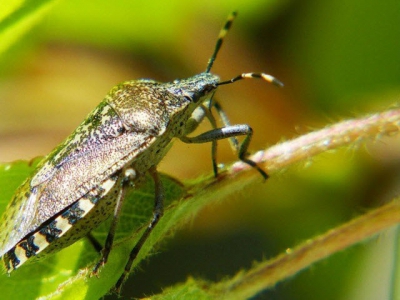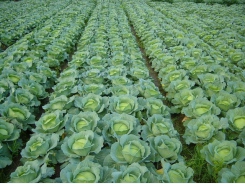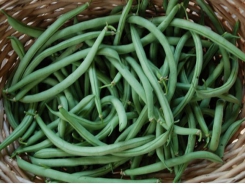10 Organic Pest Control Methods

If your vegetable garden is overrun with pests, the first step is to identify the invader. Snap a photo of the pest and compare to others on the internet, or ask a local garden expert. Once you have identified the pest, now you can take proactive measures to protect your garden. There are a multitude of organic pest control methods available including chemicals, minerals, and strategic gardening techniques. Here are ten effective methods:
SPINOSAD
This option can safely be used on your fruit and vegetable crops. Spinosad is a soil-based bacterium that kills garden pests including bagworms, borers, beetles, spider mites, tent caterpillars, and loopers. Once spinosad dries, it will kill insects that ingest it, reducing your chances of harming bees or other beneficial insects if sprayed in the evening when they are not active. Comes in liquid and dust formats under a variety of brand names: just look for spinosad as an active ingredient.
spinosad organic pest killer for gardens
ROTENONE
An organic pest killer that is also moderately toxic to most mammals and occurs naturally in seeds and stems of some plants. Use this one with caution near ponds or lakes, as rotenone is extremely toxic to fish. It will kill leaf-feeding caterpillars, beetles, aphids, and thrips on vegetable and fruit crops. Give it some time, however, as it’s a slow-acting chemical that requires a few days to work.
PYRETHRIN
One of the most widely used botanical insecticides in the U.S., pyrethrin is extracted from the chrysanthemum plant. It is non-toxic to most mammals, making it an especially safe choice.
This insecticide is a powerful, fast-acting deterrent, even at low doses. Upon exposure, most flying insects will immediately drop, but may not always be killed. Some manufacturers mix pyrethrin with more fatal solutions to ensure insect death.
BT
Sure, caterpillars can be cute, but they can also wreak havoc on leafy crops. Bt is the shortened version of Bacillus thuringiensis, a naturally-occurring bacteria that makes pests sick when ingested. Spray on leafy vegetables that caterpillars eat and Bt will kill them from the inside out. Because it’s only harmful upon eating, this is an extremely safe organic pesticide for preserving beneficial insects.
Spray out of direct sunlight (which will reduce its efficacy after several hours) and repeat every 7-10 days until no longer needed. Bt products can potentially include Genetically Modified strains, so be sure to check the packaging to verify the formula’s contents.
NEEM OIL
Neem is extracted from a common Asian tree and inhibits the growth cycle of insects. Its active ingredient, azadirachtin, will cause infected insects to eat less, grow more slowly, and molt less. This is a good option for those who don’t yet have major pest infestations and want to get a head start on reducing the quantity of potential pests.
Because of its growth retardation effects, neem oil works best on young insects and insects that grow rapidly such as squash bugs, Colorado potato beetles, and Mexican bean beetles. It is also effective on smaller, leaf-eating caterpillars and aphids.
Best of all? If you have surplus neem oil, you can spray it on vine crops that are at risk for powdery mildew, as neem is slightly effective at preventing this plant disease.
DIATOMACEOUS EARTH
If you are opposed to using chemicals–albeit organic–around your vegetable crops, considering sprinkling food-grade diatomaceous earth in your garden bed.
This powder is actually composed of fossilized diatoms, which are part of the algae group. Diatoms have a hard skeleton; when the powder comes in contact with insects, sharp edges will cut their bodies and cause them to die of dehydration within two weeks of application. The particles are so small, however, that they will not cut people or pets.
Diatomaceous earth is best used in dry instances and becomes less effective when wet. While it also targets some indoor bugs, it will kill Japanese beetles, cutworms, flies, ticks, crickets, slugs, and other species. Unfortunately, it will kill beneficial insects, so use caution.
MINERALS
Certain minerals can also be used to control pests. Sulfur is sold as a liquid, wettable dust, or paste and will control spider mites, psyllids, and thrips. Use on vegetables like beans, potatoes, tomatoes, or peas. While it is non-toxic to humans, it may irritate skin and eyes. The downside to using sulfur is that it has been shown to damage plants in dry weather when temperatures reach above 90 degrees Fahrenheit, and it is incompatible with other pesticides.
Bordeaux mixture is another organic pest control mineral that targets insects on many vegetable crops. It may damage plant leaves if applied in cool, wet weather. Chemically, bordeaux is a mixture of copper sulfate and calcium hydroxide (lime).
BENEFICIAL INSECTS
Not all insects are destructive pests. Some insects are beneficial in that they will actually attack and feed on other insects. You’ll want to attract these insects to your vegetable garden: ladybugs, lacewings, ground beetles and lady beetles, praying mantis, and parasitic wasps, to name a few.
In order to attract these types of insects, try planting these plants around the borders of your garden: cornflower, mountain mints, ornamental grasses, fennel, pussy willow, corn, or golden marguerite.
COMPANION PLANTING
Companion planting is a gardening technique in which different plants are planted within proximity to one another to control pests, maximize space, and to increase crop productivity, as well as for pollination purposes. Crops will provide habitat to insects that may feed on nearby insects inhabiting other crops.
Detailed information can be found on many websites, but here are a few favorites: carrots can be protected by nearby leeks, earth flies will avoid radishes that are planted near lettuce (which smells badly to that insect), mice will be repelled by a row of daffodils, moles by a border of castor beans, and rabbits by onions.
TRAP CROPS
While crops may attract pests you don’t want, you can use this same theory to attract unwanted pests away from wanted crops. Trap crops offer pests an alternative that will save the crop you want to harvest.
Trap crops are typically interspersed with other crops (every few rows) or planted around the perimeter of a garden. In fact, they’re planted prior to other crops to attract flying insects, who avoid landing on bare soil. Plant your trap crops to coincide with your pests’ invasion times.
If trap crops become overrun with pests, you can simply destroy the crops. This may not even happen, since beneficial pests will also be attracted to those pests….
Tools

Phối trộn thức ăn chăn nuôi

Pha dung dịch thủy canh

Định mức cho tôm ăn

Phối trộn phân bón NPK

Xác định tỷ lệ tôm sống

Chuyển đổi đơn vị phân bón

Xác định công suất sục khí

Chuyển đổi đơn vị tôm

Tính diện tích nhà kính

Tính thể tích ao




 The relationship between nitrogen & organic matter
The relationship between nitrogen & organic matter  How to handle fresh produce
How to handle fresh produce